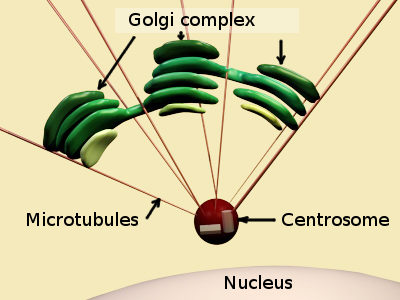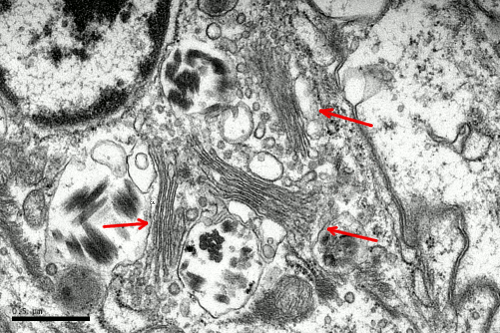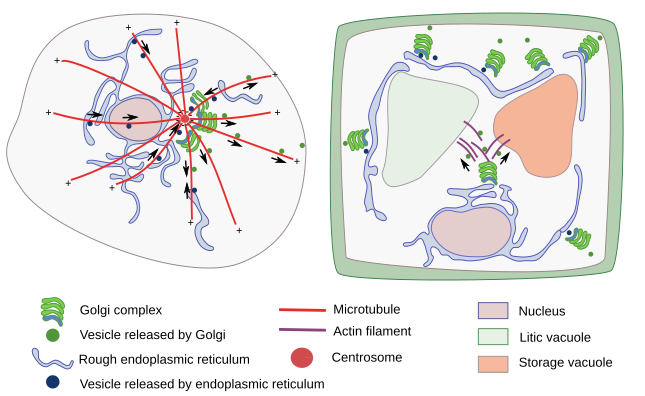Do Animal Cells Have A Golgi Complex
This folio alphabetize
one. Morphology
two. System
3. Models
4. Functions
Golgi appliance was discovered by Camillo Golgi in 1889, when he was studying neurons, only it was no completely accepted every bit a true organelle for decades. Membrane system of the Golgi apparatus was described in item by Dalto and Felix (1954) by using transmission electron microscopy. They proposed the name Golgi apparatus.
1. Morphology
In creature cells, the Golgi appliance is commonly located close to the centrosome, which in turn employ to exist near the nucleus. This position is determined by the interactions of Golgi membranes with microtubules. Microtubules are radially oriented with their minus ends anchored to the centrosome. Golgi apparatus is made upwards of flat cisterns piled in several stacks. Each stack is referred as dictyosome (Figures 1 and two). cisterns are normally thinner in the middle and thicker in the edges (similar pizzas), and are more or less bent showing a convex and a concave surface. Several stacks are present in ane cell and some cisterns are large enough to be part of two near stacks (Figure 1). The number (normally 3 to viii) and the size of the cisterns in i stack are variable and depend on the cell type, as well as the cellular physiological state. In one cell, the Golgi apparatus includes all the stacks and their lateral connections.


Inorth creature cells, there is a fibrous poly peptide matrix where Golgi cisterns are located that may help to maintain the Golgi apparatus construction. Yet, information technology has been shown that the structural integrity of the Golgi appliance mainly relies on microtubule arrangement (Effigy 3). The position of the Golgi apparatus depends on microtubules nucleated from the centrosome, whereas the stack integrity is maintained by microtubules nucleated from the Golgi cisterns. Actin filaments and myosin motor proteins assist to fine-tune the final location of Golgi stacks. In addition, the Golgi apparatus structure depends on the vesicular trafficking betwixt the Golgi appliance and the endoplasmic reticulum. When this trafficking is stopped the Golgi apparatus disappears.

In plant cells, which practice non accept centrosomes, there are minor stacks of cisterns or even private cisterns dispersed throughout the cytoplasm (Effigy 3). The Golgi apparatus looks like divided in many units distributed through the cytoplasm. Each of those units piece of work independently. Found Golgi apparatus cisterns are smaller than in animal cells, although the total number in a cell could range from dozens to more than a hundred. In plant cells, ERGIC (see below) has not been observed, but the trans Golgi network (TGN) is well developed, so much that some authors endorse it every bit a different organelle. Private cisterns or stacks are moved thanks to actin filaments and are found around the transitional areas, where there is vesicle formation by the endoplasmic reticulum. The stack arrangement does not change during these movements. Vesicles released from the stacks that are targeted to vacuoles are moved by actin filaments likewise. 1 more feature of Golgi appliance organization in plant cells is that cisterns exercise not disappear during mitosis, as it occurs in animal cells, considering Golgi apparatus is needed for synthesizing the new cell wall that separate the ii new cells during cytokinesis.
Thither are differences in the Golgi appliance organization depending on the jail cell type and in unlike species. For instance, the fruit fly cells evidence a Golgi apparatus organization like to that of plant cells, although they accept centrosome. Furthermore, the lateral connections betwixt adjacent cistern stacks accept only been observed in mammalian cells.
2. System
Golgi apparatus is a polarized organelle. Cistern piles are organized in domains: cis, intermediate and trans domains (Figure 4). Intermediate cisterns locates between cis and trans domains. In the cis domain, there is an ongoing add-on of new material coming from the endoplasmic reticulum via the ERGIC (endoplasmic reticulum Golgi intermediate compartment) compartment. In the trans domain, there is a tubulo-vesicular arrangement of the membranes, referred to equally TGN (trans Golgi network), where molecules are distributed into vesicles and tubules in their way toward other cell compartments. Thus, molecule journey through the Golgi appliance starts in the cis cisterns, goes through intermediate cisterns, and ends in the trans domain. The Golgi apparatus is in permanent renewing and its organization and size is affected by the trafficking of molecules. It is particularly well-adult in those cells showing an intense secretory activity. The resident Golgi enzymes involved in modifying the molecules that become through the organelle are selectively distributed in a specific domain (cis, intermediate or trans) co-ordinate to the chemical reaction they are performing.

3. Golgi apparatus models
a) C isternal maturation model (Figure 5). It proposes that ERGIC bodies get fused betwixt each other to form the first cistern at the Golgi cis domain. Then, this cistern moves toward the trans domain, where it is eventually split up in vesicles. The internal material of the cistern is progressively processed during this journey, i.east., there is a maturation of the cistern. Currently, this is the most accepted model because it can explain some observations that do non fit in other models.

b) V esicular send or stationary cisternae model. In this model, ERGIC and vesicles coming from the endoplasmic reticulum are fused with the cis cistern. From cis cistern, vesicles bud and fuse with the adjacent cistern of the Golgi stack. In this way, the molecules are transported by vesicles from one cistern to the side by side, while they are specifically candy in each cistern. The cistern of the trans domain does non disappear when molecules are packaged into vesicles. The support for this model has declined nowadays.
c) C onnection by tubules. Tubular connections betwixt adjoining cisterns take been observed at electron microscopy. These connections are like bridges that appear to be transient and depending on the material to be processed. This proposal is not incompatible with the other models, since tubular connexion may happen in both between stable cisterns and betwixt cisterns that move through the stack.
Functions
a) The Golgi appliance is the main glycosylation middle of the cell. Many carbohydrates that course part of glycoproteins, proteoglycans, glycolipids and other polysaccharides, such as hemicellulose in plants, are added and modified in the Golgi apparatus. Sialic acid is a carbohydrate specifically added in this organelle. Carbohydrates are added through a particular blazon of binding known as O-type glycosylation, which is the zipper of carbohydrates to the hydroxyl groups of the amino acids, such as serine, threonine and hydroxylysine. Sulfation of proteoglycans also happens in the Golgi apparatus, also as phosphorylation, palmitoylation, methylation, and other chemical modifications. In plants, the glycosylation function of the Golgi apparatus is essential considering many glycoconjugates are function of the prison cell wall. Nonetheless, cellulose is synthesized at the cell membrane.
Carbohydrates are added by glycosyltransferases and removed by glycosidases. About 200 different types of these enzymes can be found in the Golgi apparatus. Different cisterns take different roles in the carbohydrate processing, which is an ordered process. Evidences suggest that there is a concentration gradient of enzymes, from cis- to trans-domain, and so that those enzymes involved in the starting time steps of glycosylation are concentrated on the cis domain, and those participating in the terminal steps are mostly constitute near the trans domain.
b) The synthesis of sphingomyelins and glycosphingolipids is achieved in the Golgi apparatus. Ceramide, synthesized in the endoplasmic reticulum, is the molecular base used by enzymes located in the Golgi apparatus for synthesizing these lipids. VLDL (very low density lipoproteins) are apolipoproteins that are besides assembled in the Golgi apparatus.
c) Golgi apparatus is a eye for aircraft molecules coming from the endoplasmic reticulum or synthesized in the Golgi apparatus. Once processed, molecules are distributed into unlike types of vesicles which are targeted to other cell compartments. In the trans domain, TGN is the structure where this process takes place (run into figure). Some vesicles are moved to and fused with the plasma membrane, process known equally exocytosis. At that place are two types of exocytosis: constitutive and regulated (see side by side folio). Furthermore, in that location are vesicles leaving the trans domain targeted to late endosomes/multivesicular bodies/lysosomes, or to vacuoles in plants. Trans domain is too a target for other vesicles coming from endosomes, where some molecules are recycled. In plants, Golgi apparatus can receive vesicles directly from the plasma membrane. Thus, Golgi appliance participates in both, endocytosis and exocytosis.
A variety of vesicle morphologies arise from tubular expansions of the TGN membrane complex, not just typical circular-shape vesicles. Molecules must be selected and included in specific vesicles to be shipped to different targets. Those transmembrane proteins targeted to late endosomes (and basolateral membranes in epithelial cells) are selected by a item amino acid sequence of the cytosolic domain. However, molecules targeted to plasma membrane (or to the apical membrane of the epithelial cells) are selected past selectins which recognize O and N glycosidic bonds. Cytoskeleton moves vesicles to their target compartment. For example, in creature cells, microtubules transfer vesicles to the plasma membrane, whereas in plant cells, vesicles targeted to vacuoles are propelled along actin filaments.
d) Golgi apparatus performs other not-conventional functions. It works as a calcium shop, every bit an intracellular signaling platform, contributes to the cellular levels of sterols, starts the cell response to starvation, and is a microtubule nucleator.
Bibliography
Farquhar, MG, Palade GE. 1981. The Golgi apparatus (Complex) - (1954-1981) - from artifact to center stage. The journal of cell biology. 91: 77s-173s.
Glick, BS, Luni A. 2011. Models for Golgi traffick: a disquisitional assessment. Cold Spring Harbor perspectives in biology. three: a005215.
Vildanova MS, Wang W, Smirnova EA. 2015. Specific organization of Golgi apparatus in establish cells. Biochemistry (Moscow). 79: 894-906.
Source: https://mmegias.webs.uvigo.es/02-english/5-celulas/5-golgi.php
Posted by: hernandezflery1974.blogspot.com

0 Response to "Do Animal Cells Have A Golgi Complex"
Post a Comment